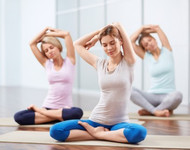Beginners Guide to Yoga & Types of Yoga in UK
Posted by Johnny Fincham
Yoga as a practice has never been more popular in the West, even the sleepiest village these days seems to have a yoga class in the local hall. It’s the perfect antidote to modern life.
Developed in India, Yoga is a divine-physical science and the most ancient form of self-development in existence. Stone seals have been discovered in the Indus valley showing yoga postures from around 3000BC. The Bhagavad Gita is the best known written ancient yogi text, in which God (incarnated as Lord Krisna) instructs the warrior Arjuna in yoga.
The `word "Yoga" is linguistically related to the English word ‘yoke,’ in the sense of being yoked or joined to the Absolute, Brahman, the Godhead.
Anyone can practise yoga - young or old, stiff or flexible. Yoga reduces stress and releases energy from tension - seized muscles; it extends the connective tissue, and tones the internal organs; it increases circulation, while decreasing the heart rate. The spine is also strengthened, while the breathing exercises increase ‘prana’, the life force.
Yoga practice can become a sort of physical meditation, though it’s actually a prelude to meditation itself. It restores the schism between body and mind endemic in our over - neurotic culture
My First Experience of Yoga
My own practice began eighteen years ago, when I approached my first class, one sleepy Sunday morning with the mother of all hangovers, borrowed track suit bottoms and some trepidation. I imagined the class to be all leotards and elastic - limbed, lentil - eaters.
The first shock was the number of men, nearly half the class were male, the second shock was that I’d need a spine broken in at least four places to get any where near the positions I was taught.
My ‘bow’ posture had all the curving grace of a ramrod and my ‘crow’ position looked more like a dying duck, plus I could swear I had one more knee than when I started.
After struggling though several asanas (postures) and pranayama (breathing exercises) though, I had to concede I felt pretty damned marvellous, and my hangover had gone. This, if nothing else, made it worth pursuing.
‘You’re absolutely rigid with tension. Try to find the source and let go of it’, said Marjory, the teacher, afterwards. I thought ‘Me? Tense? Well, she’s not very perceptive’
I considered myself a pretty laid - back sort of character; someone relaxed and chill. However, after a further three weeks or so of practice, I began to find out how tense I really was.
And that’s the beauty of yoga: the body doesn’t lie.
The body and mind are one process, one is an expression of the other. You can’t pretend. If you're weak, the flaccid muscles won’t support you; if you’re really stiff, (assuming you don’t have arthritis) you hold a lot of tension. The problem you're having with your knee is related to the problems you’re having moving forwards in life, for example. On and on it goes, the mind’s patterns repeated everywhere in the body’s processes.
The beautiful honesty of the physical realm is the starting point for progress. Where the mind can be full of attitudes, opinions, self-deceptions; the body is constant, and changes slowly. There’s no point in forcing anything, yoga positions need a letting go and an acceptance, it’s not a struggle against the body, like going down the gym, but a constant process of growing into new postures, new experiences.
In a standing balance posture like ‘tree’ for instance, any wandering of the mind will immediately manifest as wobbling and difficulty staying balanced. While the body is reaching upward in this position, you're not stretching to get anywhere, but the sense is of opening upwards, like a flower towards the light. Like all postures, it’s a natural expression. You discover a position, rather than strain to it. Central to yoga philosophy is the ideal of non-competition, either with yourself or against others.
Most beginners require a few sessions just to get in touch with themselves physically, but the benefits start straight away.
With regular practice, enormous progress can be made, and though you won’t become elastic jointed if you're really stiff, you’ll be amazed at the physical changes and how mentally, your mind unfolds in parallel.
The idea of the chakras is instilled in yoga, these are spiritual/energy centres along the spine. They have no physical existence, but in certain postures can definitely be sensed, as awareness deepens.
One point to note is that it’s actually a problem to be hyperflexible as well as too stiff, also, men’s bodies are actually designed differently to women’s at the hips, so they’re naturally more restricted there. However, even if you're eighty, you can benefit hugely, preventing the process of physically and mentally ‘closing down’.
If you're thinking of joining a class, some explanation is necessary, because there’s a rich and diverse field of styles out there, (more forms in fact, then there are types of curry!). Each style places emphasis on different aspects of practice.
The following styles of Yoga are all being taught in the UK
- Traditional Yoga forms with both asanas and pranayama. Recommended for the beginner: Hatha, Iyengar, Svaroopa, Sivananda yogas.
- With the emphasis on active movement through a series of postures – these can be quite demanding requiring upper body strength: Ashtanga, Dynamic, Power, Bikram yogas (in Bikram the movements are performed in a very warm room).
- Passive forms with little or no asanas but with the emphasis on breathing and meditation. Not really for the physically ‘wound up’: Kundalini, Rajah, Ananda yogas.
All of the styles share a common lineage. No style is better than another; it's simply a matter of personal preference.
Yoga is experiential, that is to say it can only really be known by actually doing it.
When you begin regular practice, it’s a bit like learning to play a musical instrument. At first you may feel you have a long way to go. But the practice itself is pleasurable. When you move through the asanas daily, it’s like going through your scales. You become sensitive to the subtle eddies in the processes of the body mind: the anxiety you didn’t think you had, the flu trying to get a grip on your system, the glass of wine you drank yesterday.
Slowly the body becomes purified and opened and then the spirit can soar.
The body gently becomes a thronging instrument, playing out the dance of the soul. Anyone can experience this beautiful music, through yoga you can find yourself truly, in tune with the infinite.
© Johnny Fincham and Holisticshop 2003. All rights reserved.



